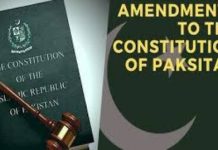ISLAMABAD, Dec 30 (DNA): Pakistan witnessed a nearly 31% reduction in
terror and counter-terror related fatalities in 2019, according to data
released by the Center for Research and Security Studies (CRSS) in
Islamabad.
Only two militant outfits, Tehrik-e-Taliban Pakistan (TTP) splinter
groups and the Islamic State (IS), claimed responsibility for 12 and 1
attacks respectively, but their own ranks depleted by nearly 30%.
Civilian fatalities declined by about 36%.
A 30.71% drop in fatalities was observed in 2019 (from 980 in 2018 to
679 in 2019). If the Khyber Pukhtunkhwa (KP) province and the former
Federally Administered Tribal Areas (FATA) are counted as separate
regions 1 , Balochistan still remains most affected of militancy and
insurgency.
The largest drop in fatalities was observed in Balochistan (44.2%),
followed by FATA (39%), Sindh (19%), and Punjab (11.8%).
Nearly 370 terror attacks were reported during 2019 that left 518
persons dead in the country. As mentioned prior, this is a 30% drop from
the 739 fatalities from the nearly 400 terror attacks in 2018.
Suicide-attacks also declined significantly this year, dropping from 26
in 2018 to 9 this year. These attacks also resulted in the loss of life
of 295 individuals in 2018, but dropped to 56 persons in 2019.
Although civilians were the most terrorism-affected group, the overall
civilian fatalities declined by about 36%. Government and security
officials’ fatalities were dropped by 19% while the militants and
insurgents had a 30% drop in their fatalities.
In 2019, no drone attack was reported as compared to four drone attacks
in last year resulting in death of 13 militants. This is quite
significant, as this marks the first year since 2004 that there have
been no drone strikes (as of December 30, 2019).
Only two militant outfits, TTP and the IS, continued claiming
responsibilities for terror attacks. However, the number of these
attacks and associated fatalities dropped significantly. IS claimed a
single attack while TTP and its splinter groups Hizbul Tahrir and
Jamat-ul-Ahrar claimed 12 attacks.
One of the causes in bringing militancy under control was the
apprehension of the outlaws belonging to various banned outfits during
this year. Of the 141 militants arrested, 32 were TTP, 11 were
Lashkar-e- Jhangvi, 3 were Al-Qaeda in the Indian Sub-Continent (AQIS),
4 were IS, 2 were Balochistan Liberation
Army (BLA), and 5 of Baloch Republican Army (BRA). In addition, 24
militants belonging to Jaish-e-Muhammad (JeM) and 2 from Jamat-ud-Dawa
(JuD) were also arrested. DNA
















